ABOUT THE C.G. JUNG FOUNDATION
Newsletter of the C.G. Jung Foundation of Ontario
ISSN 1918-6142
Chiron is a newsletter that exists to support the work of the C.G. Jung Foundation of Ontario. It was established in 1980, and has existed in electronic form since 2006. Its name and masthead image, adopted at that time, are drawn from ancient Greek culture. In Greek mythology, Chiron was the last centaur, a son of the titan Cronus. He was famed for his wisdom, knowledge and skill at deciphering the will of the gods, to healing effect.
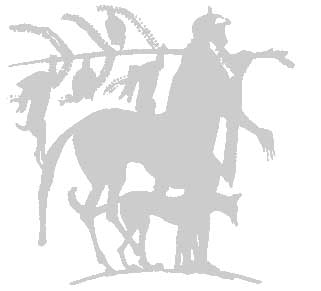
Volume 30, No. 2 Winter (January) 2011
Editor: Robert Black
| Click for PDF version of this issue for easier printing |
Contents
- Laurie Savlov on The Red Book
- Message from the President
- Andrew Benedetto on Honouring Daryl Sharp
- A Recent Graduate of the OAJA ATP
- Austin Clarkson on the "Exploring Creativity in Depth" program
- Jean Connon Unda on Walking Le Chemin
- Editorial
- New Arrivals at the Fraser Boa Library
- Changes to Website: Analyst information page
- SUBMISSIONS TO CHIRON
- Past issues
Laurie Savlov on The Red Book
Lecture and Discussion Friday Jan. 21, 2011 Seeley Hall (venue change), Trinity College 8-10pm |
The publication in late 2009 of C. G. Jung's The Red Book has become a cultural phenomenon. It is now in its seventh printing with over 54,000 copies sold. Editions in Japanese and Portuguese are underway. The Red Book has been ranked as high as number 18 on the New York Times bestseller list.
The pages of The Red Book, never published and until now not available to the public, contain images of his inner journey and struggles in his own words and hand-drawn pictures. Suddenly, we have a new source for insight into what we've read in Jung's Collected Works, his Memories, Dreams, Reflections and elsewhere.
In 1913, Jung began a new experiment in developing his self-knowledge. Jung was aged 38 and was already very well-educated in languages, religion, philosophy, medicine, and psychiatry. In his focus on self-knowledge, he entered into a lengthy process and developed a technique that he later called “active imagination.” Jung described his experimental technique as a process to “get to the bottom of my inner fantasies,” “to translate the emotions into images”, and “to grasp the fantasies which were stirring … underground.”
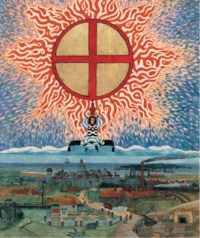 From 1913 to 1930, that is, for some 16 years, Jung wrote, edited and illustrated his personal inner journey, his self-experiment. For many years prior to starting the calligraphic Red Book, Jung wrote down his inner experiences in, at first, his brown notebook and then in a series of what he called “the Black Books.” They were leather-bound journals of a grey-black colour. He then edited the Black Books, added reflections on the text, and copied them in a calligraphic Gothic script onto parchment folios and then into a book bound in red leather. He entitled the book Liber Novus, Latin for The New Book, but the book has always been known simply as The Red Book.
From 1913 to 1930, that is, for some 16 years, Jung wrote, edited and illustrated his personal inner journey, his self-experiment. For many years prior to starting the calligraphic Red Book, Jung wrote down his inner experiences in, at first, his brown notebook and then in a series of what he called “the Black Books.” They were leather-bound journals of a grey-black colour. He then edited the Black Books, added reflections on the text, and copied them in a calligraphic Gothic script onto parchment folios and then into a book bound in red leather. He entitled the book Liber Novus, Latin for The New Book, but the book has always been known simply as The Red Book.
What we are seeing in The Red Book is Jung struggling to understand himself, his unconscious, and concepts from the collective, such as history, God, soul, etc. The writing style contrasts with what we are used to reading in the Collected Works where he presents specific theories, establishes them with many examples and illustrations, and then considers them to be proven.
The editor writes in the Introduction “The Red Book presents the prototype of Jung’s conception of the individuation process, which he held to be the universal form of individual psychological development. The writing can be understood on one hand as depicting Jung’s individuation process and on the other hand as his elaboration of this concept as a general psychological schema.”
The lecture and discussion will be suited to all interested persons, from novice to advanced Jungian − whether you have a copy of the book yet or not. It will note the experiential wellsprings of Jung's theories as well as look at what The Red Book reveals of Jung's own spiritual journey and spiritual legacy. I’m interested to hear in our discussion time how people are finding their way in the Book. Please come and share how you are learning to read it and what it has come to mean for you.
Laurie Savlov is a Jungian Analyst in private practice in Toronto and Port Perry.
Message from the President: Roger LaRade
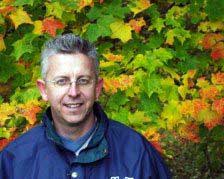 As newly-elected President of the Foundation and OAJA I wanted to take the opportunity of a new issue of Chiron to say “hello”. The election of a new Board of Directors took place at the Annual General Members meeting held September 25th, 2010. I had served on the Board as Treasurer since 2008. At the same meeting, John Affleck was elected Vice-President, Rosemary Murray-Lachapelle was re-elected Secretary, and Robert Gardner became Past-President. No one stood for election as Treasurer and that position remains vacant.
As newly-elected President of the Foundation and OAJA I wanted to take the opportunity of a new issue of Chiron to say “hello”. The election of a new Board of Directors took place at the Annual General Members meeting held September 25th, 2010. I had served on the Board as Treasurer since 2008. At the same meeting, John Affleck was elected Vice-President, Rosemary Murray-Lachapelle was re-elected Secretary, and Robert Gardner became Past-President. No one stood for election as Treasurer and that position remains vacant.
My election as President marks the first time in the history of the Foundation and OAJA that an OAJA-trained Analyst holds this position. It seems that the analyst-members of OAJA had foresight in organizing and offering a local analyst training programme beginning in the year 2000; that of providing for their succession! I hope that they see in my election a small reward for innumerable hours of planning to get the analyst training underway and even more hours in delivering the training, this in addition to running the Foundation’s public programme!
My election, of course, is but one example of the volunteer work of many other analysts graduated from the OAJA training programme. This infusion of new energy and time adds to the dynamic range of activities which OAJA analysts undertake on behalf of the Foundation. The revival of Chiron with Robert Black as Editor is a good example of this. Another is the energy that went into organizing the December 12 party honouring Daryl Sharp on the part of Caroline Deutz, Jean Connon-Unda and Andrew Benedetto, as usual so ably assisted by Catherine Johnson. So too is the assiduous work of the Public Programme Management Committee.
In assuming positions of leadership and service within the Foundation and OAJA, we ‘newbies’ do so with the awareness that we are building upon years of dedication of our predecessors who have valued the thought and work of C. G. Jung. We can but hope that our contribution will further theirs.
Andrew Benedetto on Honouring Daryl Sharp
On Sunday, December 12th, the C.G. Jung Foundation and the Ontario Association of Jungian Analysts hosted a gathering at Hart House to honour Daryl Sharp.
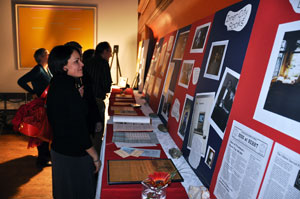 A display of Daryl's life and accomplishments was set up
by the party organizers, analysts Andrew Benedetto,
Jean Connon Unda, and Caroline Duetz, and
Foundation administrator Catherine Johnson
A display of Daryl's life and accomplishments was set up
by the party organizers, analysts Andrew Benedetto,
Jean Connon Unda, and Caroline Duetz, and
Foundation administrator Catherine Johnson
Past president Robert Gardner welcomed guests and introduced Daryl’s four children, his grandchildren, and Daryl’s brother and attending family. Daryl was recognized as a founding member of the Association together with Fraser Boa and Marion Woodman, where he held many roles including OAJA President when it began the first training program for Jungian analysts in Canada in 2000. Daryl’s accomplishments have also been distinguished by his significant contribution to the dissemination and understanding of Jung’s work as publisher of Inner City Books which celebrated its 30th anniversary this year.
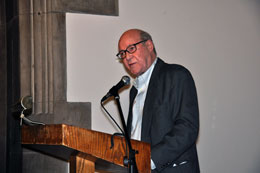 Robert spoke of Daryl’s “constancy” and “stamina” over many years and offered that Daryl is an individual who knows himself and has held true to his beliefs – certainly words of tribute in the context of Jungian psychology. He then presented Daryl with a keepsake book that included good wishes from many individuals including friends, analysands, and authors whom he has published.
Robert spoke of Daryl’s “constancy” and “stamina” over many years and offered that Daryl is an individual who knows himself and has held true to his beliefs – certainly words of tribute in the context of Jungian psychology. He then presented Daryl with a keepsake book that included good wishes from many individuals including friends, analysands, and authors whom he has published.
Beverley Bond-Clarkson gave a heartfelt speech reflecting on her long association with Daryl. On behalf of attendees and well-wishers, Beverley presented Daryl with an exquisite book that featured photographs of elephants. Beverley recalled that Daryl first discovered a small carved elephant while walking on a path during his training in Zürich, and ever since it has proved to be an important symbol in his work.
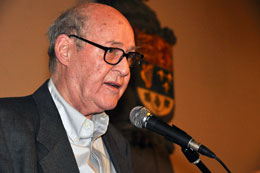 Daryl thanked his family as well as those individuals with whom he has worked closely at the Foundation and Inner City Books. Daryl provided his perspective on his many experiences and made note that he has no plans to retire!
Daryl thanked his family as well as those individuals with whom he has worked closely at the Foundation and Inner City Books. Daryl provided his perspective on his many experiences and made note that he has no plans to retire!
Though Marion Woodman was unable to attend, current president Roger LaRade happened to be teaching at the Foundation office when the telephone rang – it was Marion’s husband Ross who offered to dictate Marion’s good wishes. Roger arrived at Hart House just before the champagne toast to Daryl, and read her words. Marion called Daryl’s publishing “a gift to the Jungian world” and recognized his support to her and other authors for whom he had launched many a career.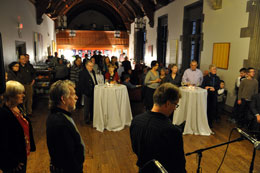
Catering was provided by Hart House, and guests were treated to live music performed by local band Whiskey Jack, a much-welcomed contribution from Duncan Fremlin and the band members.
Andrew Benedetto is a Jungian Analyst in private practice in Toronto. Ben Sharp, the photographer, is Daryl’s son and a freelance Director of Photography.
Knowledge should not be dead material that has been memorized; it must possess a living quality, and be infused with the experience of the person who uses it. C.G. Jung, CW 10, para. 324 |
A Recent Graduate of the OAJA Analyst Training Programme
At a graduation ceremony held in the C. G. Jung Foundation office last October 23, a new graduate received his Diploma in Analytical Psychology, and was added to the list of those qualified to practice as a Jungian Analyst.
15. PAUL ADAMS.
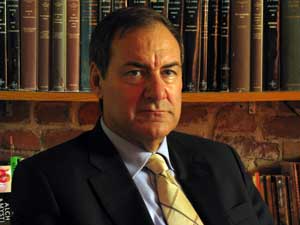 Paul Adams, the most recent graduate of the OAJA ATP, has had a private psychotherapy practice in Windsor, Ontario, since 1997. Besides treating individuals, he runs dream groups for interested people. A native of the United Kingdom, Paul had studied and taught in Canada before deciding to immigrate in 1980. He has worked in a number of fields including Addictions, Residential Treatment as a treatment coordinator, Child Protection, Adult and Youth Corrections and Community Development. In concert with community agencies, he has established a number of treatment strategies and protocols related to child sexual abuse, and in 1994 founded and directed an assessment and treatment program for adult sex offenders. He holds service contracts with provincial and federal correctional services and the office of the Crown Attorney. With a life-long interest in literature, including obtaining a Masters in Creative Writing, Paul Adams’ thesis in Jungian training was related to the work of Albert Camus. The focus was on the story, “The Adulterous Wife” in the collection Exile and Kingdom. The thesis explored the archetypal themes of waiting, betrayal and the desert that arise out of Camus’ story. He is married to Nancy and has two daughters, and recently became the grandfather of triplets.
Paul Adams, the most recent graduate of the OAJA ATP, has had a private psychotherapy practice in Windsor, Ontario, since 1997. Besides treating individuals, he runs dream groups for interested people. A native of the United Kingdom, Paul had studied and taught in Canada before deciding to immigrate in 1980. He has worked in a number of fields including Addictions, Residential Treatment as a treatment coordinator, Child Protection, Adult and Youth Corrections and Community Development. In concert with community agencies, he has established a number of treatment strategies and protocols related to child sexual abuse, and in 1994 founded and directed an assessment and treatment program for adult sex offenders. He holds service contracts with provincial and federal correctional services and the office of the Crown Attorney. With a life-long interest in literature, including obtaining a Masters in Creative Writing, Paul Adams’ thesis in Jungian training was related to the work of Albert Camus. The focus was on the story, “The Adulterous Wife” in the collection Exile and Kingdom. The thesis explored the archetypal themes of waiting, betrayal and the desert that arise out of Camus’ story. He is married to Nancy and has two daughters, and recently became the grandfather of triplets.
Austin Clarkson on the “Exploring Creativity in Depth” program
“Exploring Creativity in Depth” is a five-hour arts enrichment program that engages the imagination and puts children in touch with their authentic creative potential. 4,000 children grades 1 to 8, with their teachers and parent-volunteers from schools in predominantly “priority” neighbourhoods have attended the program since 2002. Participants make two oil pastel pictures, write poems and stories about them, then discuss and interpret their artwork in small groups facilitated by artist-teachers from the Milkweed Collective. The two-fold cycle of the creative process evokes meaningful and often transformative experiences in the students, the teachers, and the accompanying parent-volunteers. For more on the program, samples of student artwork, and bios of the staff, see www.exploringcreativity.ca.
Visioning Exercise, Grade 1
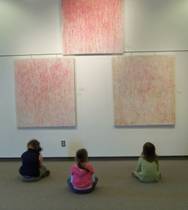
The ECiD program originated in a university course that was given during the 1980s and 1990s to undergraduates in fine arts at York University. “Foundations of Creative Imagination” was based on Jung’s concepts of the creative imagination and the transcendent function, the analysis of myths and fairytales, archetypes and psychological types, the creative process and the ritual process (Clarkson 2005). The instructors included specialists in visual art and music, movement, voice and story-telling, and the psychology of Jung. Marion Woodman was the analyst on the team during the first few presentations of the course, and when she had to withdraw on account of her health, Beverly Clarkson took her place. As director, I administered the course and took care of the musical side of things.
In April of 1995, at the final meeting of the course, that class of students decided they wanted to continue meeting. Immersed since the fall in weekly sessions of intense creativity and intellectual enquiry, the students had formed such a close-knit community that they did not wish to part. We continued to meet three of four times a year at various locales to keep in touch and engage in further creative exercises. Some dropped out, while others joined, and by 1999 we decided to go public as the Milkweed Collective. Our first public workshop was in collaboration with the Metro Toronto Task Force to Bring Back the Don. The first day culminated in “A Gathering of Waters,” led by Basia Irland, the sculptor and environmental artist, who has conducted similar projects on major rivers of the world. We spent the second day at the Centre for Creative Ministries in Massey Creek Park, where the participants revisited in their imaginations the spot where they did their solo the day before among the ancient willows by the river. They moved that experience into clay, drawings and sharing with the group.
Picture-making, Grade 7
 Since then the Milkweed Collective has given four exhibitions (2000, 2002, 2004, 2009) at the Neilson Park Creative Centre in Etobicoke, along with workshops on the creative process. Each year the group undertakes a round-robin creative process and gathers in the summer to share the results. This past summer the group celebrated its 15th anniversary.
Since then the Milkweed Collective has given four exhibitions (2000, 2002, 2004, 2009) at the Neilson Park Creative Centre in Etobicoke, along with workshops on the creative process. Each year the group undertakes a round-robin creative process and gathers in the summer to share the results. This past summer the group celebrated its 15th anniversary.
The Exploring Creativity in Depth program is the subject of the Report, “My Mind a Beautiful Thing”: Imagination, Art, Creativity in Elementary Education. The Report describes the ECiD program and assesses its effects. Teacher questionnaires and interviews provide information on the effects of the ECiD on their attitudes to art, the imagination, and creativity. Teachers affirm that the program increases their confidence in teaching art, and they provide examples of how they apply concepts and methods from the ECiD in language arts, social studies, and other subject areas. Teachers reflect on the effects on student creativity, use of the imagination, confidence and self-esteem, ability to pay attention, and empathy and social skills. They also note positive effects on self-understanding, metaphorical thinking, inferencing, creative problem-solving, and appreciation of different points of view.
Interpretation group, Grade 4
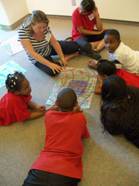 Student questionnaires provide data on what they learned about the imagination, about art, about themselves, and about their classmates. Several hundred statements from student feedback forms are analyzed with respect to the categories: Mind, Imagination, Art, Creativity, Identity and Community. The drawings and writings of 27 students from grades 1 to 8 illustrate the transformative effects of the creative process. The discussion takes up the topics of Northrop Frye revisited, educating the creative imagination, creativity, the creative process and transformation, reflective learning and visioning, and the Revised Ontario Arts Curriculum. The Report concludes with 16 recommendations on the role of the arts in the core curriculum, the capacity of teachers to implement the Revised Ontario Arts Curriculum, and the importance of reflective learning and creativity in elementary education.
Student questionnaires provide data on what they learned about the imagination, about art, about themselves, and about their classmates. Several hundred statements from student feedback forms are analyzed with respect to the categories: Mind, Imagination, Art, Creativity, Identity and Community. The drawings and writings of 27 students from grades 1 to 8 illustrate the transformative effects of the creative process. The discussion takes up the topics of Northrop Frye revisited, educating the creative imagination, creativity, the creative process and transformation, reflective learning and visioning, and the Revised Ontario Arts Curriculum. The Report concludes with 16 recommendations on the role of the arts in the core curriculum, the capacity of teachers to implement the Revised Ontario Arts Curriculum, and the importance of reflective learning and creativity in elementary education.
Warm Up Activity, Grade 3
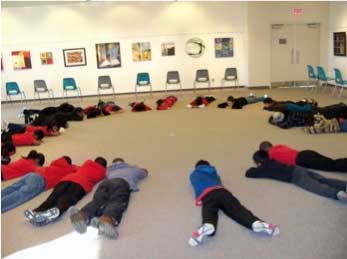
References:
Clarkson, A. (2002). A curriculum for the creative imagination. In T. Sullivan & L. Willingham (Eds.), Creativity and Music Education, pp. 52-76. Toronto: Canadian Music Educators Association.
Clarkson, A. (2005a). Educating the creative imagination: A course design and its consequences. Journal of Jungian Scholarly Studies, 1(2). www.thejungiansociety.org.
Clarkson, A. (2005b). “Structures of fantasy and fantasies of structure”: Engaging the aesthetic self. Current Musicology, 79-80: 67-94.
Clarkson, A. (2008). The dialectical mind: On educating the creative imagination in elementary school. In, R. Jones, A. Clarkson, S. Congram, N. Stratton (Eds.), Education and Imagination: Post-Jungian Perspectives, pp. 118-141. London: Routledge.
Clarkson, A. (2010). “My mind a beautiful thing”: Imagination, Art, Creativity in Elementary Education. Toronto: Soundway. The Report can be downloaded from www.exploringcreativity.ca.
Austin Clarkson, Ph.D., professor of music emeritus, York University, is director of the Milkweed Collective. clarkson@yorku.ca
If you want to write something, you have to be quite sure that the whole of your being wants this kind of expression. (...) Therefore don't hurry and better wait until the thing begins to grow out of itself. C.G. Jung,Letters, II, 1 December 1960 |
Jean Connon Unda on Walking Le Chemin
This September, I walked a 220K section of the Camino de Santiago de Compostela in France – Le Chemin, from Le Puy En Velay to Conques. It was a profound journey, an experience of walking into deeper and deeper attunement with the mystery of the natural world and of my own nature. How can I even begin to communicate something like this? As Rumi says, “Language is a tailor shop in which nothing quite fits.”
Experience in depth requires the use of symbolic language, as in poetry or art or spirituality. Jung says a word or image is symbolic “… when it implies something more than its obvious and immediate meaning. It has a wider ‘unconscious aspect’ that is never precisely defined or fully explained. Nor can one hope to define or explain it. As the mind explores the symbol, it is lead to ideas that lie beyond the grasp of reason.” (C.G. Jung, Man and His Symbols, p. 20-21 )
Even physicists turn to symbolic language when they talk about mystery. Erwin Schrodinger writes: “...this life of yours that you are living is not merely a piece of the entire existence, but is, in a certain sense the whole; only the whole is not so constituted that it can be surveyed in one simple glance. This … is what the Brahmins express in that sacred, mystic formula that is yet really so simple and so clear: Tat tvam asi, that is you.” 
Symbolic modes of expression allow the “unsayable” to be circumabulated, glimpsed and felt from different angles,
hinted at through multiple images and metaphors, all the
while honouring the numinosity of the experience. For it is a “secret of life” that we cannot pin down in logos terms - to try
to do so would be to reduce, distort, even suffocate it. At most we may sketch it with a light hand, leaving spaces where the gods might enter. With that in mind, I’ve chosen some photos
I took along Le Chemin. I invite you to spend some time with these images – perhaps some will speak to you.
View all of Jean's photos here.
Jean Connon Unda is a Jungian Analyst in private practice in Toronto.
EDITORIAL:
It’s a very simple truth: what you accept to be true psychologically will affect your behaviour. Notions about the psyche have personal and social consequences.
Sometimes the conduct that emerges out of psychological principle is not very life-enhancing. Imagine, as I saw recently, a young man walking south on Yonge Street whose ears were blocked by an iPod, and who was busy “texting” on an iPhone as he stepped off the curb. A few seconds after he glanced at the cross-light, it changed against him. He was almost killed by a driver who had the right-of-way.
Maybe he just never gave it a passing thought, and simply believed that his inner life was nothing. But whether or not it was conscious, that fellow acted as if his inner life had no special value, and his “sub-”conscious were a by-product, an “epiphenomenon,” a psychic basement into which rejected contents get shoved. This is a notion from Freud that seems gradually to be prevailing in Western culture. And if it’s true – if – it would make perfect sense to impede whatever tried to slip back out. What better way to block unwelcome fantasies or “bad” thoughts than to distract your mind with sound, movement, colour, distraction? Even if it gets you killed.
But if, rather, as we have learned from C.G. Jung, the Unconscious is a multi-layered marvel – connecting us from the personal stratum down through family, tribal, national and other layers to the Collective Unconscious, the “psychic residue” of human life, the “two-million-year-old mind” – then our behaviour would be very different. No iPods for most of us. Making the telephone or the computer mobile and omnipresent is not an attractive thought. Rather, peacefulness, silence, quiet, receptivity – these are the things to be cultivated, supporting what Edward Edinger coined “the Ego-Self Axis.”
When the face we turn to the depths is one of interest, welcome, openness, curiosity, and even gratitude, the response and energy we get back are of a similar quality. We get energy, and are sustained in a life of balance and creativity.
Increasingly, the reproach that used to be directed at Christianity – “why are there so many denominations?” – is being applied to psychology. “Why are there so many different approaches to the psyche?” It’s because your beliefs affect your behaviour. Ideas have personal and social consequences.
The society growing around us can bear to read, and re-read these words from Jung’s autobiographical memoirs (page 235f):
[We] have plunged down a cataract of progress which sweeps us on to the future with ever wilder violence the further it takes us from our roots. Once the past has been breached, it is usually annihilated, and there is no stopping the forward motion.
But it is precisely the loss of connection with the past, our uprootedness, which has given rise to the ‘discontents’ of civilization and to such flurry and haste that we live more in the future and its chimerical promise of a golden age than in the present, with which our whole evolutionary background has not yet caught up. We rush impetuously into novelty, driven by a mounting sense of insufficiency, dissatisfaction and restlessness. We no longer live on what we have, but on promises, no longer in the light of the present day, but in the darkness of the future, which, we expect, will at last bring the proper sunrise. We refuse to recognize that everything better is purchased at the cost of something worse; that, for example, the hope of greater freedom is canceled out by greater enslavement to the state, not to speak of the terrible perils to which the most brilliant discoveries of science expose us. The less we understand of what our fathers and forefathers sought, the less we understand ourselves, and thus we help with all our might to rob the individual of his roots and his guiding instincts, so that he becomes a particle in the mass, ruled only by what Nietzsche called the spirit of gravity.
Reformers by advances, that is, by new methods of gadgets, are of course impressive at first, but in the long run they are dubious and in any case dearly paid for. They by no means increase the contentment or happiness of people on the whole. Mostly, they are deceptive sweetenings of existence, like speedier communications which unpleasantly accelerate the tempo of life and leave us with less time than ever before. 'Omnibus festinatio ex parte diabloi est,' -- all haste is of the devil -- as the old masters used to say.
It’s hard to imagine how such a small and generally introverted group might influence things for the better. But if we live by our truth, and let it influence the way we behave in the outer world as well as the inner, perhaps our little oases of peace and creativity might draw others to find the same respite in consciousness that we have found for ourselves.
New Arrivals at the Fraser Boa Library
There are quite a number of new arrivals at the Jung Foundation library. The DVD collection is getting quite large, and can be perused when the offices are open on Thursdays. The library has been cleared of materials not strictly “on topic” that have also never been borrowed, so there is some room for new book titles. We note, with interest, that a great many new books on Jungian themes are collections of short essays, instead of book-length approaches to this or that topic. While we mull on this development, here are some glimpses of a few titles now available for you.
A columnist at The Globe & Mail named Micah Toub has written a seemingly light but ultimately insightful memoire entitled Growing Up Jung; coming of age as the son of two shrinks (Doubleday Canada, 2010). Not many children grow up in a household where dream analysis and self-reflection looms large, but for Toronto resident Toub this was the case. The son of two Jungian analysts, he puts an honest, critical and at times amusing eye on such important and disparate topics as Shadow, C.G. Jung and the Jungian worldview, Judaism, relationships, and Individuation. Not to be missed.
Jungian analyst Stanton Marlan has brought together a collection of essays by eight Jungian analysts called Fire in the Stone; the Alchemy of Desire. Published by Chiron a few years ago, it treats of various topics that might be grouped together as “soul making” in the 21st century.
We now have three meaty volumes from Spring Journal Books, generated by “students of Jung” Robert and Janis Henderson, called Living with Jung; ‘Enterviews’ with Jungian Analysts. This collection is of reflections from over forty analysts about C.G. Jung, and the Jungian world and approach as it has been and now is. As might be expected from such a large assemblage, some accounts are worth their weight in gold, and others, well, distinctly the opposite. Some of just a few names that will be familiar to many readers are (in volume 1) Adolf Guggenbuhl-Craig, Joseph Henderson, James Hall, Murray Stein; (in volume 2) Mario Jacoby, Robert Henderson, James Hollis, a memorable and moving piece from our own John Dourley, Verena Kast; (in volume 3) John Hill, Linda Shierse Leonard, Marvin Spiegelmann, and Wolfgang Giegerich. This is a rare glimpse “from the inside.”
And speaking of “our own John Dourley,” he has kindly donated to the library a copy of each of his new books. Paul Tillich, Carl Jung and the Recovery of Religion (Routledge, 2008) shows how Tillich’s theology and Jung’s psychology have a common ancestry in and dependence on German mysticism and share a concern for the recovery of a valid religious sense. On Behalf of the Mystical Fool; Jung on the Religious Situation (Routledge, 2010) discusses the emergence of a new mythic consciousness which supersedes usual concepts of religion “to provide a spirituality of more universal inclusion.” Jung’s critique of traditional western religion and his teaching about the psyche is very much related to “a myth of much wider compass” which is seeking expression in the new religiosity and spirituality emerging in our time.
We are always glad for suggestions of Jungian titles, books and DVDs, for our collection. Please be in touch with the Library and Archives Chair, Robert Black.
Changes to Website: Analyst information page
Addition of Paul Adams, Windsor
Margaret Meredith has moved office, Toronto
Terilyn Graham Freedman, London, has a new email address
Only if you are able to see the relativity, i.e., the uncertainty of all human postulates, can you experience that state in which analytical psychology makes sense. C.G. Jung, Letters, II, page 303f. (May 1956) . |
SUBMISSIONS TO CHIRON
The C.G. Jung Foundation’s members and friends are very welcome to submit pieces for publication in Chiron. We would particularly welcome short articles (under 1000 words) on archetypal material, and very short (under 500 words) “book notes” and film reviews. Longer pieces can be negotiated, especially if serialization is possible.
We very sincerely promise that our responsibility to cast an eagle editorial eye over these submissions will be lightly and not impertinently applied, and that you will see beforehand any results of our meddling; so that the full essence of your insights and the character of your “voice” is kept safe and sound in the published version.
Hyperlinks in the electronic version of Chiron
Hyperlinks in the electronic version of Chiron do not imply or constitute endorsement of the organization or individual concerned, and are provided as a courtesy in current issues only. The C.G. Jung Foundation of Ontario is not responsible for the content of such sites.
Past issues available online
Back to top







